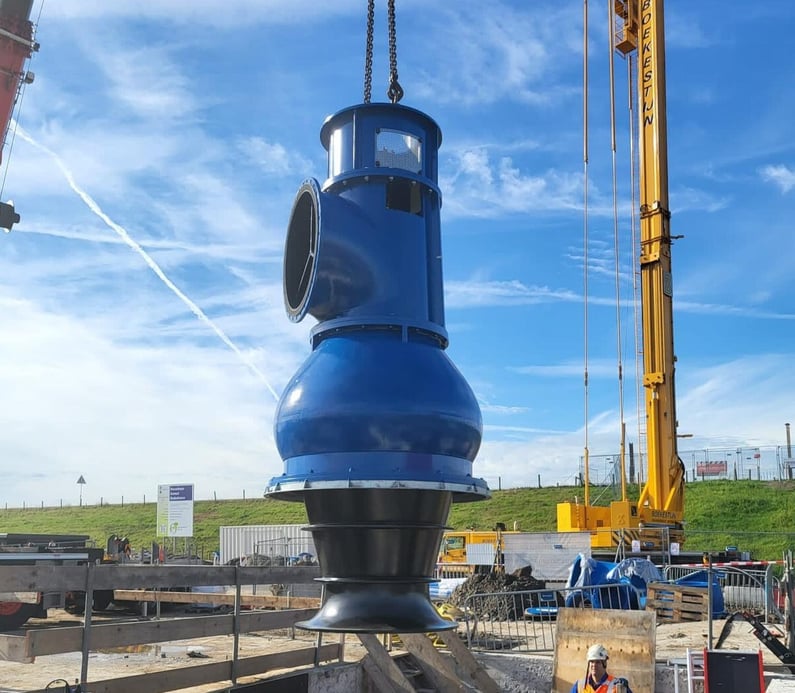With fish passage now a legal, ecological, and cultural requirement for New Zealand’s water infrastructure, selecting the right stormwater pump means thinking beyond flow rates. Engineers, asset managers, and civil contractors are increasingly being asked to balance hydraulic performance with fish safety, whole-of-life cost, recyclability, and compliance with NES-F and iwi values.
Here’s how three leading fish-friendly pumps stack up: Bosman Vision vs. Axial Flow vs. Archimedes Screw Pumps.
1. Hydraulic Efficiency & Performance ⚙️
| Pump | Hydraulic Efficiency | Head (Lift Capacity) | Operating Range | Scalability |
| Bosman Vision Series (MC & CV) | Up to 85% efficiency | Up to 8m head | Wide, cavitation-free operating range, no pilot pump required | Easily retrofittable with higher-powered motor for future flow needs |
| Axial Flow | ~75% efficiency | ~5m head | Suitable for traditional low-head, high-volume flood control | Limited scalability; fish-friendly impeller in development |
| Archimedes Screw | Unknown | Limited to low-head lift (<2–3m) | Constant-speed operation; not designed for head pressure | Seismic constraints. Suited to lifting water within catchments as discharge over stop-banks not ideal. |
Bosman Vision pumps are designed in direct response to fish-friendly requirements, with verified mortality rates under 2% and fish-safe configurations that align with regulatory and cultural expectations. This is supported by field studies in Europe, conducted independently and without Bosman’s knowledge and made available after the studies’ completion.

2. Fish Passage, Guidelines & Impeller Design 🐟
| Pump | Fish Mortality Rate | Impeller Design | Species & Sizes Tested |
| Bosman Vision Series (MC & CV) | <2% (independently verified) | Mixed-flow screw impeller with one leading-edge blade | European eel (Anguilla anguilla) 200–1030 mm, roach, bream, perch, pike |
| Axial Flow | In-market (NZ). Low mortality reported | Dual leading-edge axial impeller | NZ longfin/shortfin eel testing scheduled for 2025 |
| Archimedes Screw | Low mortality rates | Slow-turning screw impeller | In-house trials on eel, smelt, whitebait-sized species up to 300mm, longfin eel up to 1600mm |
Fish-Friendly Pumps NZ - Parameters Affecting Fish Mortality
Fish mortality when passing through pumps is influenced by factors related to both pump design and the species of fish. The main factors include:
- Pump Passage: The open passage for objects to pass through without contacting any moving or stationary parts of the pump.
- Pump Speed: Higher speeds can create greater barometric pressure differentials and increase the velocity of the impeller blades, leading to impeller strikes, the most common cause of fish mortality.
- Number of Blades: Fewer blades reduce the likelihood of impeller strikes, making the pump more fish-friendly.
- Capacity: High-capacity pumps (>500L/s) may be more fish-friendly than smaller ones.
- Head: The pump’s designed manometric pressure impacts the barometric pressure within the pump.
- Species: Fish species vary in size and shape, with certain species (e.g., eels) more vulnerable to injury.
Fish-friendly pumps have significantly reduced mortality rates by implementing slower rotation speeds, larger passages, and specialised blade designs that minimise physical contact with aquatic life while maintaining efficient water movement.
What the NZ Fish Passage Guidelines Say:
From the NZ Fish Passage Guidelines v2.0 (2024):
- All instream structures must maintain or improve fish passage (Section 2.3, NPS-FM).
- Flood pump stations should avoid creating barriers for migratory species such as tuna (eels), īnanga, and smelt (Section 4.9.1).
- A recommended fish mortality rate is <2% for taonga species (Section 3.2).
- Design considerations include:
- Impeller strike reduction: Fewer leading-edge blades preferred.
- Safe swimming velocities: 0.6–1.2 m/s for adult tuna.
- Lubrication: Oil-free/water-lubricated bearings preferred to avoid contamination (Section 5.5.8).

3. Environmental & Cultural Fit 🌱
|
Pump |
Lubrication |
Construction Material |
Recyclability |
Waterway Risk |
|
Bosman Vision MC & CV |
Water-lubricated |
Cast steel |
Fully recyclable |
None |
|
Axial Flow |
Grease-lubricated |
Cast steel |
Fully recyclable |
Grease may contaminate waterways |
|
Archimedes Screw |
Grease-lubricated |
GRP (Glass Reinforced Plastic) |
Not recyclable |
Moderate contamination risk |
Seismic Safety: Screw pumps require heavy concrete works, posing risk in liquefaction-prone sites. Bosman’s lightweight, containerised system is better suited for seismic regions compared to FishFlow Innovations or MacEwans pumps.
4. Construction, Transport & Maintenance
|
Pump |
Footprint |
Construction Cost |
Transport |
Maintenance |
|
Bosman Vision Series |
Small, modular |
Minimal groundwork; no forebay required |
Containerised; easy to freight |
Low OPEX; fewer moving parts |
|
MacEwans Axial Flow |
Traditional layout |
Moderate |
Local NZ support |
Medium OPEX; grease servicing required |
|
Archimedes Screw |
Large civil footprint |
High |
Bulky site-dependent |
Unknown |
Summary: Choosing the Right Fish-Friendly Pumps NZ
|
Scenario |
Best Option |
|---|---|
|
Retrofit with future-proofing |
Bosman Vision MC |
|
New-build station |
Bosman Vision MC &CV |
|
Low-head ecological lift |
Archimedes Screw |
|
Budget upgrade, basic compliance |
Axial Flow |
|
High cultural/legislative scrutiny |
Bosman Vision MC or CV |
About Prime Fluid Management
Prime Fluid Management has worked alongside New Zealand’s civil and municipal sectors for more than 20 years, providing reliable fluid pumping and treatment systems both in a temporary (emergency response) and permanent capacity.
Our experience spans both new-build and retrofit installations, including sites with challenging environmental, cultural, or seismic considerations. We support engineers, councils, and contractors with practical, fit-for-purpose advice and technologies that meet today’s ecological expectations - around fish passage, energy efficiency, and whole-of-life value.
We supply and support a wide range of fish-friendly and flood-resilient pumping systems, including the Bosman Vision Series and other future-ready solutions.




